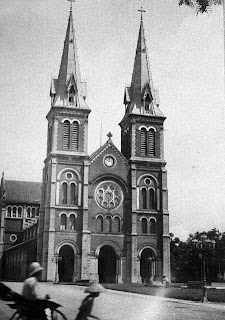From the first to the sixth centuries, the area where Saigon now stands was under the sway of the Funan empire and was occupied by Khmer fishermen. They found its stable ground an ideal base for fishing in the nearby Mekong Delta, though it amounted to no more than a village at the time, which went by the name of Prey Nokor.
 |
| (Vietnam) - Saigon in my heart - History |
Little more is known about the city’s development until the 17th century, when the Nguyen lords based in Hue expanded their sphere of influence this far south. By this time, the village had grown to be a town that attracted traders from China, Malay and India. In order to protect the town from attack, an octagonal walled citadel was built in the centre called Gia Dinh. It was around this time that the Khmer name of Prey Nokor was changed to Saigon.
 |
| (Vietnam) - Saigon in my heart - History |
During the mid-19th century, French colonial interests began to focus on this region and in 1859 they conquered the city. By the Treaty of Saigon (1862), the French declared Saigon the capital of French Cochinchina, and set about re-building the city along European lines. Financing for filling in canals, road building and erecting showy, colonial villas came mostly from the rice and rubber barons who were making a fortune out of plantations they controlled.
 |
| (Vietnam) - Saigon in my heart - History |
In the late 19th and early 20th century, the colonial era reached its peak, and visitors were often amazed by what became known as the ‘Paris of the Orient’, with its shady boulevards and sturdy mansions. However, the Second World War brought about unexpected change as the Japanese overran Southeast Asia. After the conflict, the British Army were given the task of clearing out the Japanese from this region and they promptly restored the French to power.
 |
| (Vietnam) - Saigon in my heart - History |
Hatred of their colonial oppressors had led to minor uprisings in the past, but it was not until the French returned to power that the fight for independence really got started. Even then, there was little fighting in the area around Saigon, but when the French were finally defeated at Dien Bien Phu in 1954 in the north, most Vietnamese thought their troubles were over.
 |
| (Vietnam) - Saigon in my heart - History |
Sadly, this was not to be. By the terms of the Geneva Accords, Vietnam was divided at the 17th parallel, splitting the country into two, and Saigon became the capital of the Republic of South Vietnam in 1955. Rather than solve the country’s problems, it just polarised the north and south and led to what was to become one of the most famous wars of the 20th century.
Though most Westerners know this conflict as the Vietnam War, for obvious reasons it is known to the Vietnamese as the American War, to distinguish it from other wars with the French and Chinese. It is also sometimes referred to as the Second Indochina War.
This was when the name Saigon appeared in regular news bulletins, as it became the main base for American troops eager for some rest and recreation after nerve-racking spells at the front line. The city remained a dangerous place, however, with student demonstrations, occasional bombings and monks immolating themselves in protest at the war.
After American troops withdrew in 1973, it was only a matter of time before the Communist north overran the south to reunify the country, and Saigon was the last city to fall in April 1975.
(Thoang Saigon and Google Search)

No comments:
Post a Comment